by Lisha Vidler
I have in my possession two petticoats from the late 19th century. It’s hard to date them conclusively, but I can say for sure that they are later in style than the 1860s. They lack the fullness to fit over a large bustle, so they can’t be from the early 1870s or mid 1880s. They could potentially be from the Natural Form period, between 1877 and 1882, when skirts became narrow and the bustle vanished. The trim is stitched horizontally on both, which places them before the trademark style of the late 1890s and early 1900s, with their vertical bands of lace. Therefore, my best guess places the petticoats from either the Natural Form period or the early Belle Epoch period: either 1877-1882 or 1888-1893.
First Petticoat
The first petticoat I bought from a well-known seller of antique garments on eBay. I believe it’s made of a very fine linen, with cotton lace.
The waist measures 35.5” flat, but can gather smaller; the hips are 50” around; the sweep measures 66” on the inner layer (around the hem); the length from waist to hem is 32.5” in the front and 34.5” in the back. You’ll notice it is slightly longer in the back. This is likely so that it could be worn over a small bustle pad, like those worn in the late 1880s and early 1890s. The waist fastens by means of a drawstring of narrow twill tape, however a couple of pleats are permanently stitched down, so no matter how large a waist you tie it around, there will always be a slight amount of fullness.
The petticoat is comprised of one layer from waist to knees and then two layers from the knees to the hem. The under layer is plain, with a simple hem, while the outer layer consists of nine rows of lace carefully stitched together with a heading of five impossibly narrow pintucks.
The lace is of two kinds: a grape cluster with leaves, and a scrolling vine pattern. They alternate, grape on top, then two rows of vine, two rows of grape, two rows of vine, and the final two rows are grape with the last being a scalloped version.
While some of the edges have begun to fray slightly, all of the sewing in this petticoat is impeccable. The seam joining the two layers is carefully flat-felled. The lace is hand stitched together. The side seams are machine stitched and then finished using a technique that I’ve failed to find in any of my sewing books. The placket is done using a method found in Dressmaking by Butterick, 1911.
Interestingly, there are two loops made of a loosely woven twill tape secured to the side seams at the waist. I believe these were to hang the petticoat from. One is perfectly intact, however the other has, unfortunately, frayed considerably and come loose from its seam.
Overall, this petticoat is in astonishingly good condition for a garment that’s more than 120 years old! I feel no qualms whatsoever about wearing it. In fact, on one occasion, when I lacked a long slip on a cold winter night, I wore it beneath a maxi-skirt in order to keep warm. It did its job admirably, proof of our ancestors’ dressmaking skills.
Second Petticoat
The second petticoat is not so well made and yet is quite beautiful nonetheless. I believe it is made of a fine cotton, with cotton lace.
I bought this one from an unknown seller on eBay and had nothing but trouble. The seller claimed the petticoat was in “good condition” and showed photos to substantiate this. When the petticoat arrived, however, I found a massive coffee stain across much of the lower skirt, along with scattered rust stains. The back had been ripped a good eight inches alongside the center back seam, and there were numerous other tears and holes in the fabric and lace. They had all been artfully hidden by the camera angles, and the seller denied any problems. After much argument, and the initiation of a claim with PayPal, the seller finally offered to give me a partial refund. Because the petticoat was so beautiful, I decided to take my chances with effecting repairs, and thus accepted the discount.
The waist measures a little over 29” with no adjustable gathering; the hips are 43” around; the sweep (around the bottom) measures 62” as the top of the ruffle; from the waist to the hem it’s 33” in front and 35.5 in back. This one, too, is longer in the back, however it perplexes me because the gathering at the waist is slight. It would likely not fit over a bustle pad. It’s possible that the petticoat originally had a smaller, gathered or pleated waist, and that someone took the excess fabric out in order to expand the waist; unfortunately, any evidence of this would have been lost when I repaired the damage to the petticoat, and I didn’t think to examine it with that in mind before I began fixing it.
Like the other, it’s comprised of two layers that are stitched together about knee high, with a single layer from the knees to the waist. The under layer is plain, with a narrow ruffle at the edge, while the outer layer has rows of pintucks and lace.
On this outer layer there are 3 layers of wide lace, all the same, with the bottom row being scalloped. At the top is a row of geometrically-styled Broderie Anglaise, and above that, twelve rows of tiny pintucks at the top.
The hem of the underlayer has been done with an tiny heirloom catch stitch, which has created a row of little holes along the hem.
The seams are done with a peculiar method of finishing that I haven’t been able to find described in any sewing manual. It appears that the seam is stitched as normal, with right sides together, then the seam is pressed to one side. The raw edge is folded under twice and then stitched. This creates a finished seam that resembles a French seam, and yet which is created after the seam is stitched in a normal fashion.
A few inches above the seam connecting the two layers, there is a ½” tuck taken around the petticoat. Originally, it had been twice as wide in the front, making the petticoat even longer in the back. I cannot be sure if this was so the petticoat could be worn with a slightly trained dress, or if the original owner wanted to wear it with a small bustle. As there currently wasn’t enough fullness for it to fit over the bustle I owned, and the petticoat was rather short for me, I decided to go ahead and adjust the tuck to make it the same length all the way around. This gave me about an inch more length in front, and kept the back just long enough to fit over a slight bustle pad should I wish, and not be noticeable otherwise.
Originally the waist tied with two lengths of twill tape, not a drawstring, just sewn to the edges of the waistband. When I repaired it, I added two small hooks and eyes instead.
Much of the lace was covered with the coffee or tea stain. After some research, I decided to soak the whole petticoat in a solution of water and OxiClean® powder. It required hours of soaking, and the application of a thick paste made by mixing OxiClean® powder with a little water, but eventually it faded. You can still see the remnants of the stain in good lighting, but I didn’t want to risk damaging the antique fabric by further stain-removal attempts.
-
Disclaimer: Please be cautious about repairing any antique garments that you may own. Fabrics are more fragile than they look; damage can be easy to inflict and difficult to mend. Only attempt to fix an antique garment if: 1. You know what you’re doing; 2. If leaving it un-mended would eventually cause further damage; or 3. If it’s a common item that museums have a surplus of, and therefore you won’t be depriving future generations of something valuable.
I felt grieved that I had to repair the petticoat so drastically. I don’t know how old the damage was, but it saddened me that someone had abused such a beautiful piece of history! I hand stitched all of the tears and holes that I could find. The rips in the lace were less noticeable when I finished, and the rest give the petticoat subtle character. The tear down the back, however, required much more extensive repairs.
After examining it thoroughly, I came to the conclusion that I would need to sew a new back seam from waist to hem. I did my best to line the edges of the lace up at the bottom, however they simply refused to do so. I was reluctant to add non-period fabric in order to create a new placket, so I simply turned the edges under and stitched a narrow hem around the back opening.
The end result is a perfectly wearable petticoat. My repairs won’t win any awards, but it’s an authentic piece of history that deserved to be preserved, and now it has a much longer life ahead of it.
~~*~~
Do you own any antique garments? What have you learned about their construction and the sewing techniques used to make them?

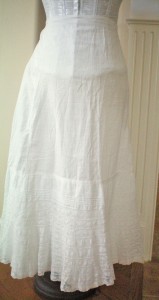
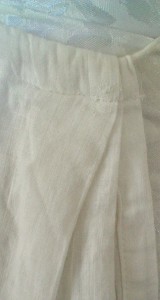
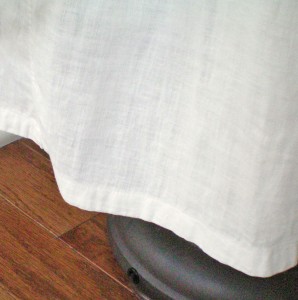
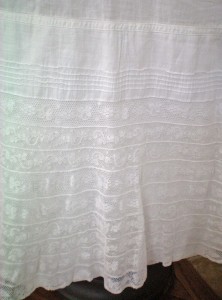
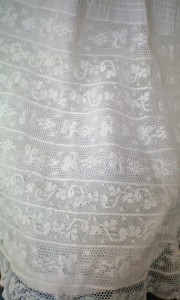
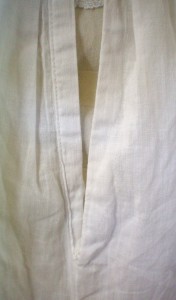
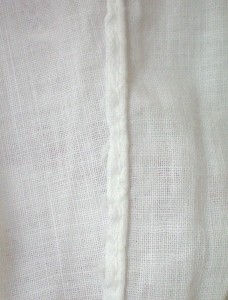
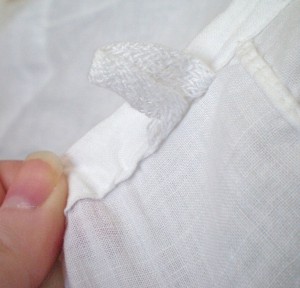
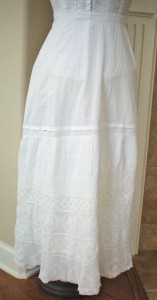
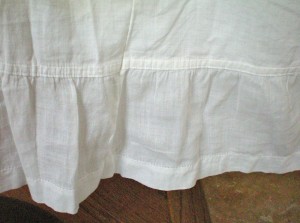
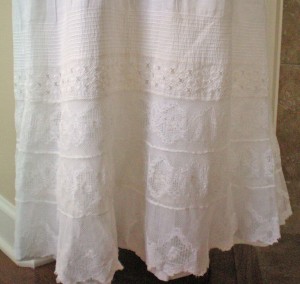
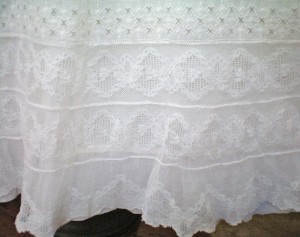
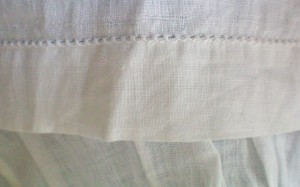
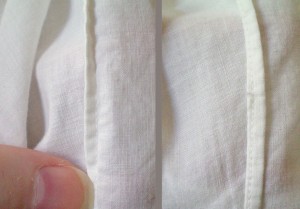
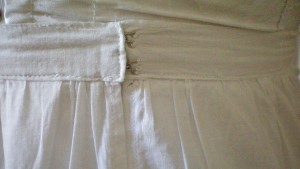
Hello. Can I buy this Petticoat? We need this Item for the Theatre.
It is a nice Petticoat.The price for this Item and shipping? Thank you.
Kind Regards Dieter W.He.
Thank you for your interest! I’m so sorry, but my antique petticoats aren’t for sale. They’re both precious to me and I couldn’t bear to part with them. Also, since they’re more than 100 years old, they’re not suitable for the rigors of being worn as theater costumes. They would quickly fall apart and be ruined! I bought both of these petticoats from eBay.com; I’m sure you’ll find something suitable there if you search for “Victorian petticoat”. You’ll typically pay between $65 and $100 for a petticoat with lace—however, be aware that any true antiques will NOT be strong enough for theater costumes. You should probably have someone sew a reproduction petticoat for your theater to use. There are a few people on eBay who do this. Thanks again, and I’m sorry I couldn’t be of more help.
Hello… I came across your post when looking for info about a couple of family clothing items. One is a petticoat, the other a Christening gown. Do you know of a good website that I can use to determine their age? The petticoat has some of the features you mention in your post and based on the ancestor I’m assuming owned it, the age could be about the same.
How wonderful that you have such great family heirlooms! I don’t know of any particular sites that are useful for identifying petticoats or christening gowns, but I might be able to help you with the petticoat, if you send me photos and answer a few questions about it. (For example, is the back longer than the front? If so, by how much? Is there any gathering at the waist? If so, how much? Does it go all the way around or is the front flat, with the gathering in the back? How full is the bottom of the petticoat? What kind of decoration does it have? Lace? Embroidery? Pintucks? Does the decoration go horizontally around the bottom of the petticoat or do vertical or diagonal bands go up and down the skirt?) Use the “Contact Me” page to send me a message if you’re interested and we can move the discussion to email. Thanks!
Hi. Are you still online? I too, have some antique family heirloom petticoats. I also have a white camisol, a blouse, and a bunch of beautifully hankerchives with tiny embroidery and cut work. Its like tiny xx;. One of the slips ties in back with a ribbon. As you mentioned above, its flat in front and gathers in back. It has two tiers of eyelet lace placed horizontally along the bottom. This is in perfect (old, used) condition. If it helps, we had a hoop skirt too. It was made of tiers of metal hoops with cotton tapes running vertically. The tapes went over the shoulder, draped over bodice and ‘strung’ the concentric hoops together. It was badly rusted, and was left behind when we moved. I discribed this to possibly help date ‘my stuff’.
Regarding the two xx above, its a typo. I meant to write ‘eyelet lace’, but that expression excaped me at the moment. The xx are remnant placeholders. cynthia